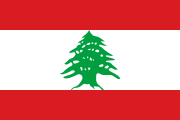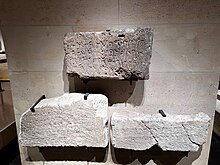
Back بوابة:لبنان Arabic بوابة:لبنان ARZ Portail:Liban French Portale:Libano Italian Portal:Lubnan Malay Portal:Líbano Portuguese Портал:Ливан Russian باب:لبنان Urdu Cổng thông tin:Liban Vietnamese
The Lebanon PortalA view of Byblos, Lebanon
 Lebanon, officially the Republic of Lebanon, is a country in the Levant region of West Asia. Situated at the crossroads of the Mediterranean Basin and the Arabian Peninsula, it is bordered by Syria to the north and east, Israel to the south, and the Mediterranean Sea to the west; Cyprus lies a short distance from the coastline. Lebanon has a population of more than five million and an area of 10,452 square kilometres (4,036 sq mi). Beirut is the country's capital and largest city. Human habitation in Lebanon dates to 5000 BC. From 3200 to 539 BC, it was part of Phoenicia, a maritime civilization that spanned the Mediterranean Basin. In 64 BC, the region became part of the Roman Empire and the subsequent Byzantine Empire. After the seventh century, it came under the rule of different Islamic caliphates, including the Rashidun, Umayyad and Abbasid. The 11th century saw the establishment of Christian Crusader states, which fell to the Ayyubids and the Mamluks. Lebanon came under Ottoman rule in the early 15th century. Under Ottoman sultan Abdulmejid I, the first Lebanese proto state, the Mount Lebanon Mutasarrifate, was established as a home for Maronite Christians, as part of the Tanzimat reforms. Lebanon is a developing country, ranked 112th on the Human Development Index. It has been classified as an upper-middle-income state. The Lebanese liquidity crisis, coupled with nationwide corruption and disasters such as the 2020 Beirut explosion, precipitated the collapse of Lebanon's currency and fomented political instability, widespread resource shortages, and high unemployment and poverty. The World Bank has defined Lebanon's economic crisis as one of the world's worst since the 19th century. Despite the country's small size, Lebanese culture is renowned both in the Arab world and globally, powered primarily by the large and influential Lebanese diaspora. Lebanon is a founding member of the United Nations and the Arab League, and a member of the Non-Aligned Movement, the Organization of Islamic Cooperation, the Organisation internationale de la Francophonie, and the Group of 77. (Full article...) This is a Featured article, one of the best articles Wikipedia has to offer.
 Bodashtart (also transliterated Bodʿaštort, meaning "from the hand of Astarte"; Phoenician: 𐤁𐤃𐤏𐤔𐤕𐤓𐤕) was a Phoenician ruler, who reigned as King of Sidon (c. 525 – c. 515 BC), the grandson of King Eshmunazar I, and a vassal of the Achaemenid Empire. He succeeded his cousin Eshmunazar II to the throne of Sidon, and scholars believe that he was succeeded by his son and proclaimed heir Yatonmilk. Bodashtart was a prolific builder, and his name is attested on some 30 eponymous inscriptions found at the Temple of Eshmun and elsewhere in the hinterland of the city of Sidon in Lebanon. The earliest discovered of Bodashtart's inscriptions was excavated in Sidon in 1858 and was donated to the Louvre. This inscription dates back to the first year of Bodashtart's accession to the throne of Sidon and commemorates the building of a temple to the goddess Astarte. The Temple of Eshmun podium inscriptions were discovered between 1900 and 1922 and are classified into two groups. The inscriptions of the first group, known as KAI 15, commemorate building activities in the temple and attribute the work to Bodashtart. The second group of inscriptions, known as KAI 16, were found on podium restoration blocks; they credit Bodashtart and his son Yatonmilk with the construction project and emphasise Yatonmilk's legitimacy as heir. The most recently discovered inscription as of 2020 was found in the 1970s on the bank of the Bostrenos River, not far from the Temple of Eshmun. The inscription credits the King with the building of water canals to supply the temple in the seventh year of his reign. Three of Bodashtart's Eshmun temple inscriptions have been left in place; the others are housed in museums in Paris, Istanbul, and Beirut. Bodashtart is believed to have reigned for at least seven years, as evidenced by the Bostrenos River bank inscription. Little is known about his reign other than what has been learned from his dedicatory inscriptions. (Full article...) Did you know (auto-generated) -
TopicsRelated portalsReligions in Lebanon Arab states Other countries This is a Good article, an article that meets a core set of editorial standards.
The Assaf dynasty (also called Banu Assaf) were a Sunni Muslim and ethnic Turkmen dynasty of chieftains based in the Keserwan region of Mount Lebanon in the 14th–16th centuries. They came to the area in 1306 after being assigned by the Bahri Mamluks to guard the coastal region between Beirut and Byblos and to check the power of the mostly Shia Muslim population at the time. During this period, they established their headquarters in Ghazir, which served as the Assafs' base throughout their rule. Under the leadership of Emir Assaf, they were confirmed as the rulers of Keserwan by Sultan Selim I following the Ottoman conquest in 1516. Emir Assaf died two years later and was succeeded by his son Hasan, who was in turn killed by his brother Qa'itbay. The latter ruled Keserwan until his death without children in 1523, after which he was succeeded by Hasan's son Mansur. Mansur had a long reign and was accorded by the Ottomans numerous districts in Mount Lebanon and its environs as tax farms. He eliminated many of his Sunni rivals, and his local power relied on a Maronite Christian support base and his Maronite agents, namely members of the Hubaysh clan, who served as a check on the Shia Muslim sheikhs of Keserwan. At the peak of his power, Mansur's realm stretched from Beirut to Homs. Mansur was dismissed in 1579 and replaced by his son Muhammad, who was imprisoned by the authorities in 1584 for alleged involvement in a looting raid against an Istanbul-bound caravan. He was restored to Keserwan in 1585 and was given tax collection authority over the rural districts of Tripoli Eyalet; this brought him into conflict with the Sayfa clan, the Assafs' erstwhile Turkmen clients, one of whose members, Yusuf Pasha Sayfa, was governor of Tripoli. The Assaf realm dissipated in 1591 when Muhammad was killed while attempting to collect taxes from the Sayfas in Akkar. Afterward, Yusuf Pasha Sayfa married Muhammad's widow and inherited the Assaf realm. (Full article...) General imagesThe following are images from various Lebanon-related articles on Wikipedia.
CategoriesAssociated WikimediaThe following Wikimedia Foundation sister projects provide more on this subject:
SourcesDiscover Wikipedia using portals |






















































